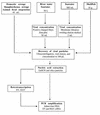Viral pollution in the environment and in shellfish: human adenovirus detection by PCR as an index of human viruses
- PMID: 9726885
- PMCID: PMC106735
- DOI: 10.1128/AEM.64.9.3376-3382.1998
Viral pollution in the environment and in shellfish: human adenovirus detection by PCR as an index of human viruses
Abstract
A study of the presence of human viruses (adenoviruses, enteroviruses, and hepatitis A viruses [HAVs]) in environmental and shellfish samples was carried out by applying DNA and cDNA amplification techniques by PCR. The detection of human adenoviruses by PCR was also examined as a potential molecular test to monitor viral pollution. The samples studied were urban and slaughterhouse sewage, river water, seawater, and shellfish. Enteroviruses were quantified by PFU in Buffalo green monkey kidney cells and fecal coliforms and phages of Bacteroides fragilis HSP40 were also evaluated in some of the samples. The amplification of viral DNA and cDNA has shown a high prevalence of human viruses that would not be detected by the use of classical techniques, such as the quantification of PFU in cell lines. The results of the analysis of slaughterhouse sewage samples together with the test of farm animal feces indicate that the adenoviruses and the HAVs detected in the environment are mostly of human origin. A significative correlation between the detection of human viruses by PCR and the values of bacteriophages of B. fragilis HSP40 in urban raw sewage was observed. Human adenoviruses were the viruses most frequently detected throughout the year, and all the samples that were positive for enteroviruses or HAVs were also positive for human adenoviruses. The results suggest that the detection of adenoviruses by PCR could be used as an index of the presence of human viruses in the environment where a molecular index is acceptable.
Figures


References
-
- Allard A, Albinsson B, Wadell G. Detection of adenovirus in stools from healthy persons and patients with diarrhea by two-step polymerase chain reaction. J Med Virol. 1992;37:149–157. - PubMed
-
- American Public Health Association. Standard methods for the examination of water and wastewater. 19th ed. Washington, D.C: American Public Health Association; 1995.
-
- Arribas A, Bosch A, Lucena F, Pares R. Survey of viral pollution in Duero river (Spain): occurrence of natural virucidal phenomena. Environ Int. 1988;14:37–41.
Publication types
MeSH terms
Substances
LinkOut - more resources
Full Text Sources
Other Literature Sources
Medical

